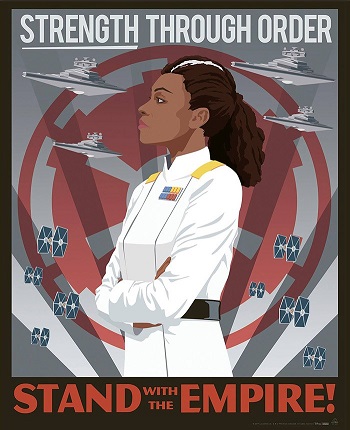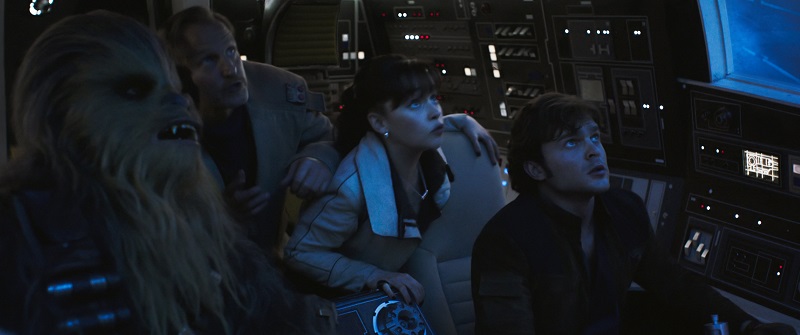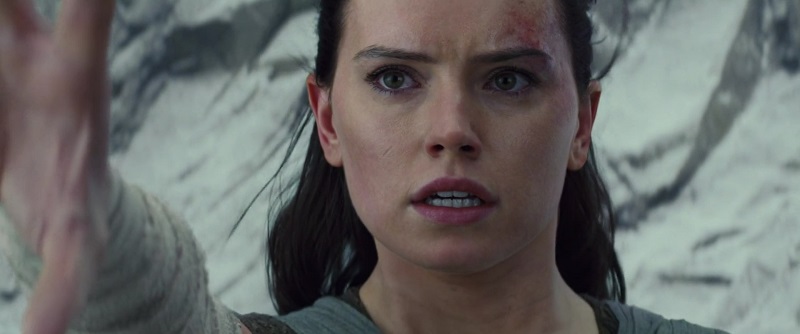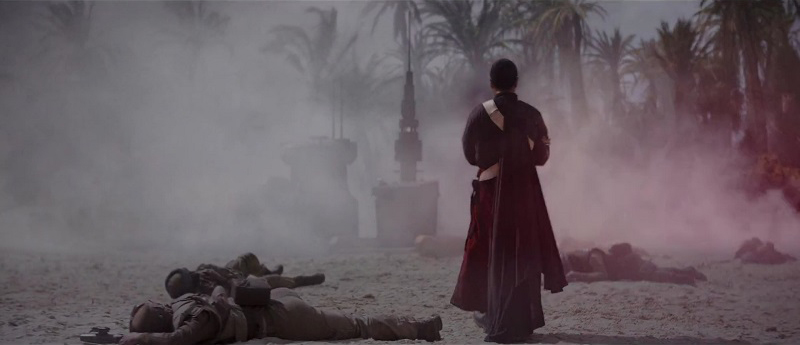Welcome to Part II of our Memorable Moments feature–Part I can be found here! This thing is long enough already so let’s get right to it…
 13. Admiral Sloane Orders the Retreat, “The Levers of Power” (Jay Shah)
13. Admiral Sloane Orders the Retreat, “The Levers of Power” (Jay Shah)
Initially, my entire list of favorite moments consisted of key events from RAE SLOANE’s story across different media and throughout the timeline of novels in which we’ve seen her. That would have been a little silly for a list of moments, even though I believe RAE SLOANE’s journey through the new canon has been the most remarkable and every moment we saw her in another context was a surprise and a sheer delight. But if I had to pick a single moment, I would choose her appearance at the Battle of Endor in the short story “The Levers of Power” — it’s the pivot point around which her whole career orients and changes.
Before the Battle of Endor, RAE SLOANE is a dutiful Imperial true believer who does the right thing as she sees it but is unable to rise as far as she merits due to the Empire’s internal politics and her unwillingness to play those games. After the Battle of Endor, RAE SLOANE is one of the most powerful forces in the Empire and becomes the very face of its surviving military as a grand admiral (literally, in the case of propaganda posters).
“The Levers of Power” shows Admiral RAE SLOANE on the precipice, just as her Empire is. It is a harrowing story. The Battle of Endor felt like it could go either way, until disaster mounted on disaster and it couldn’t. We see all the classic hallmarks of RAE SLOANE: her tactical skill, her dislike for power games (exemplified by a particularly odious ISB loyalty officer), and her ability to cut through the expected to get things done. She does not suffer the loyalty officer’s second-guessing as she leads as ably as any Imperial officer could. More than that: when she has to make the key decisive call that the battle is lost and duty requires the fleet to be preserved, she shoots the loyalty officer dead and gives the order to retreat. She has to.
Admiral SLOANE drew on the focused ruthlessness that had distinguished her in A New Dawn, and she also drew on the characteristics that would prove to be so important in her post-Endor Aftermath story arc: her ability to see that something new needed to be done. “Forget the old way”, Vidian’s old mantra, became true as ever.
During the Battle of Endor, we saw everything that RAE SLOANE had been and would become. It was her varied career in a nutshell, and it was RAE SLOANE in a nutshell. And I’ll never forget my first time reading it.
 12. Jyn Arrives at Five Points, Rebel Rising (David Schwarz)
12. Jyn Arrives at Five Points, Rebel Rising (David Schwarz)
Jyn Erso’s life story might well be the most tragic story in all of Star Wars. Think of her short yet painful life: from refugee on a backwater world to terrorist, to wanderer, to criminal, to eventually a martyr for the whole galaxy. She had all the reasons to give up and to let the galaxy that had abandoned her sort itself out, yet she found immense strength in having nothing to lose. The novel Rebel Rising depicted this short life, the years in between the Rogue One prologue and when we see her again in the Wobani penal colony, and closed the second act with a particularly powerful sucker punch.
Not long after Saw Gerrera abandoned her, Jyn was residing on a little world called Skuhl, having managed to find an adoptive family in the Pontas, freighter captain Akshaya and her son Hadder, who would become Jyn’s first love. But her happiness was brief. Thanks to the indiscretions of a Partisan recruiter, the Empire came knocking. Jyn managed to escape in a small ship followed by Akshaya and Hadder in their freighter, Ponta One, and after crossing the cloud of TIE Fighters surrounding the planet, Jyn managed to jump her very damaged ship to Five Points Station. But she gets there alone, with no trace of the Ponta family. After waiting for a while, Jyn realizes with horror that the damage her ship had sustained was caused by shrapnel–shrapnel clearly recognizable as coming from Ponta One. Akshaya and Hadder never even made the jump.
In the space of about ten pages, we see Jyn lose her family for the third consecutive time, we feel the creeping horror as she starts to suspect that something has gone wrong and we eventually come to the realization that she’s lost everything once again. Only one of her many false identities, Tanith Ponta, survives the ordeal. The cynical and distant Jyn that we meet in the novel’s opening is born at this particular point: when Jyn finally gets tired of losing. This is the lowest point of Jyn’s very dark life, and it makes us appreciate her light so much more.

11. The Kessel Run, Solo (Nick Adams)
“You’ve never heard of the Millennium Falcon? It’s the ship that made the Kessel Run in less than twelve parsecs.”
Like many things in A New Hope, George Lucas didn’t waste a lot of time with exposition. A Republic fell and an Empire rose? Check. Jedi hunted down during a dark time? Check. A rebellion against the Empire? Check. In this era where fans have four decades of movies, old canon, and new canon, we forget that good chunks of core lore were originally left unexplored. To Lucas, the Kessel line was all the audience needed to know about Han Solo and his beloved Falcon. In Solo, we finally got the answer to the Kessel Run. It’s easy to screw up these little things, so as a fan I had a bit of trepidation. In the first two acts of the film, there were some hits, but nearly as many misses. Watching it on opening night, I knew that the third act would make or break it. Fortunately, they knocked this part out of the park.
The Kessel Run is, for lack of a better analogy, like a well-made cocktail. Hell, let’s run with this analogy and say one made in Lando’s well stocked bar on the Falcon. We have a measure of excitement, a pour or two of top-notch special effects from ILM, another pour of high stakes action, and several dashes of an epic music score. John Powell has an amazing knack for combining classic themes from John Williams with a mix of his own beats to create some truly epic tracks. Reminiscence Therapy and Into the Maw (the 3:46 mark of the latter track begins one of the best fanfares of the entire film, if not the wider saga) exude the spirit of Williams’ works and bring the audience right back into the dash, pulp, and fun of the Star Wars saga. Looking back, I’m still amazed how well they pulled off this scene. We knew that Han, Chewie, and Lando would be okay. We knew that the Falcon would make it. Still, despite all that we knew, they found a way to tell the story—visually, thematically, and musically—in top notch fashion.
While Solo isn’t in my top five Star Wars films, the Kessel Run has truly become one of my favorite moments from the overall saga. A single line from ANH generated a fun movie and a truly epic part of the film. I still marvel over what they can do with a single line. “Rebel spaceships, striking from a hidden base” formed the basis for the phenomenally popular Rogue One. Who knows that other lines may one day spawn an exciting book, TV show, or film? Maybe one day we’ll finally learn about the “many Bothans” that died too…

10. Luke Says Goodbye to Leia, The Last Jedi (Ben Wahrman)
This scene is, for me, the capstone of why I love The Last Jedi. It’s artistic, it’s emotional, it’s subtle and oh so poignant. There’s a lot to be said about how good Carrie Fisher and Mark Hamill are together in this scene, as well as the blocking of the camera and other directing subtleties to enforce how they are together yet apart (set up by Rey and Kylo’s visions, and foreshadowing Luke’s Force projection reveal). There’s even more to be said about John Williams’ score in this scene and his use of not only Leia and Luke’s themes but Han’s as well, or about the weight of the dialogue and of course Luke’s now-famous line, “no one’s ever really gone.”
But let’s not mince about. The reason this is on the list is that it’s the last time we’ll ever have these two now-immortal characters interacting on screen as portrayed by their original actors. Carrie Fisher’s untimely passing lends each of her scenes in The Last Jedi an extra layer of gravitas and weight, but what makes this scene unique is that it was very consciously created as a farewell scene. There is so much history between Luke Skywalker and Leia Organa, and all of it is summed up at once in this one, brief, heartrending moment.
It’s the quiet before the storm. Luke is about to march out to face his nephew again, to stall the might of the First Order, allow the Resistance time to escape, and then to pass into the Force. But before he goes anywhere, he needs to see and speak to one person, and one person only. Stories oftentimes don’t have the luxury of ending well, let alone poetically. But The Last Jedi ends the story of Luke and Leia just so: Luke Skywalker is here to rescue you, Princess Leia, one last time.

9. “I would trust her with my life”, Rogue One (Jay Shah)
Every single moment with Bail Organa on screen in Rogue One was memorable for many reasons, not least because the first time we saw the film my friend would punch me in excitement every time he appeared. But mostly it’s the sheer weight of everything: the audience knows who he means. The audience knows Bail Organa’s faith in Leia is justified. The audience knows that Alderaan is coming. At that point, we still don’t know how things will turn out in the film. But like Bail Organa, we know that it will all be okay.
See — that’s the thing about this moment. It’s as much about Leia as it is about Bail Organa. And it was very poignant with Carrie Fisher passing away during the theatrical run of Rogue One. It took on an extra weight, as we all felt and truly believed what Bail Organa said. Like “to me, she is royalty”, “I would trust her with my life” became one of those mantras one would use to speak about both Carrie Fisher and Leia Organa. You can trust her, and you always could.
Story-wise, it took on even more weight after the publishing of Leia: Princess of Alderaan. We saw how Leia earned the trust of her parents and how they came to support her desire to join the struggle at her young age. It’s a theme that carries a throughline from Legends to canon, from the old Brian Daley radio dramas to Star Wars Rebels: Bail Organa trusts Leia to carry things through and to do the right thing.
By the time of Rogue One, we know Bail Organa pretty well. We’ve had the prequels and The Clone Wars to thank for that. He’s an idealist and a deep thinker, and not one driven to leave things to chance. So we know that when he says he trusts Leia, it means something.
Years later, during the novel Bloodline, a statue of Bail Organa is inaugurated in front of the Galactic Senate on Hosnian Prime. It’s eventually destroyed along with the New Republic. Perhaps both would still be around if the senate had trusted Senator — and General — Leia Organa.

8. Luke’s Final Binary Sunset, The Last Jedi (Abigail Dillon)
It would be impossible to entirely unwrap this moment. Luke Skywalker has meant so much to so many people; this is a moment that will have countless inferred meanings. I could not hope to touch on – let alone encompass – them all. Instead, let me simply connect it to the very first binary sunset Luke ever saw.
The Last Jedi’s ending has often been compared to The Empire Strikes Back, but the parallels with Revenge of the Sith are likewise numerous. The (New) Republic is destroyed, its protectors greatly diminished in number and forced into hiding, no allies to come to their aid. Revenge ends with Obi-Wan settling Luke into Beru’s arms and walking away, leaving her to join Owen and watch their first sunset as a family.
Luke was nurtured to become the man – the hero – we knew by his aunt and uncle. And then we watched him fail his own nephew to a devastating degree. He openly grieves how he had failed Ben and broken Leia’s trust, but I wonder how much Owen and Beru were also on his mind. How they had poured their lives, their love, into their nephew, and Luke had not lived up to their example.
Yet as he regards his final sunset, we are told by Rey that he feels peace, no sadness. Luke cannot undo the ignition of his lightsaber that night, but he gives his life apologizing to Ben. And he does so while sheltering the hope of the galaxy from the encroaching night, like Beru and Owen did for him throughout his entire childhood.
Luke watched his first binary sunset carried in their arms. I’m convinced he watched his last carrying them in his heart.

7. The Rebellion is Reborn, The Last Jedi (Mark Eldridge)
All the richness of The Last Jedi can be found in one scene.
In the red dust of Crait, master and apprentice face each other. Luke Skywalker and Kylo Ren, damaged and disillusioned, have set out their arguments for letting the past die – violently if necessary, whether it’s burning a tree or murdering your father. Against all odds, though, Luke has returned as a Jedi, to face his failure and defend the remnants of the Resistance from Kylo’s extermination.
And there’s a third factor at play. The young woman whose Force sensitivity awakened so powerfully – and frighteningly – and has been pushed and pulled between Luke and Kylo as she seeks guidance, identity, and a hero to lead the fight against the First Order.
“The Resistance is dead!” Kylo spits, his scar livid against his sickly face. “The war is over! And when I kill you, I will have killed the last Jedi!”
“Amazing,” says Luke calmly, repeating the words Ben must have heard during his training. “Every word of what you just said was wrong.
“The Rebellion is reborn today.”
Cut to General Leia, Resistance leader; and in front of her Poe Dameron, the young man who will take it forward, who has learned the difference between heroism and leadership, and that sometimes the passive path is the most heroic of all.
“The war is just beginning.”
And there’s Finn, the born soldier without a cause, who found someone to fight for and then discovered an even greater, more selfless purpose.
Luke is looking right at us. The Force Theme rises.
“And I will not be the last Jedi.”
Rey’s eyes fly open as if she heard him, master and apprentice finally in sync. She doesn’t have a lightsaber, but being a Jedi isn’t about killing royal guards. She lifts the rocks trapping the Resistance, literally and metaphorically lifting the darkness to let in the light. The troops gaze at her in awe: they have found their beacon of hope, a hero to rally around.
Rey has made her choice, and found herself. She rescued the Jedi texts, assuming the burden of the thousand generations. The music reflects John Williams’s score for Order 66, the fall of the old Jedi, but uplifting, conveying the opposite emotion. Rey is the hero to lead the fight against tyranny and oppression. And as Finn flings his arms around her and she smiles, the happiest she has looked in the entire film, we know she has also found a family.
We’re back with Mark Hamill’s extraordinary face, and he’s smiling too, tears in his eyes. Luke has found peace. The past will always be with us. Luke’s legacy won’t be Kylo Ren and the end of the Jedi; it will be Rey, the Jedi reborn, and all the little stable hands across the galaxy inspired by the tale of Luke Skywalker, Jedi Master, facing down the entire First Order with a laser sword.
You might almost call it the rise of Skywalker.

6. Chirrut Goes For a Walk, Rogue One (Mike Cooper)
To a writer, the Force is the best plot device you could ask for. It’s a literal deus ex machina that can be used to explain all sorts of patently ludicrous things, simply because the writer wants them to happen—therefore the universe itself wants them to happen, therefore they happen. And we happily accept it! It’s ridiculous when you really think about it.
Of course, the Force knowing what it wants doesn’t mean it makes things easy. After narrowly escaping the destruction of their home, and losing the support of the Rebel Alliance that had just scooped them up, Chirrut and Baze, erstwhile Guardians of the Whills, tag along with Jyn Erso’s Rogues to steal the Death Star plans anyway. After somehow making it to the surface of Scarif, and somehow acquiring the plans, and somehow receiving air support from a Rebel fleet that wasn’t supposed to be there, Chirrut is informed that they cannot arrange the transmission of the plans to the fleet without engaging a nearby master switch to boost their communications.
It’s a classic action-movie trope, and in any other story what followed would have been something straight out of a video game: Baze and Chirrut heroically storming no man’s land, mowing down the Empire’s elite before succumbing to blasterfire, one of them then bravely crawling to the switch and pulling it with his last breath. But this is Star Wars, so instead Chirrut just gets his shit together and strolls out there.
The reason Star Wars can get away with such high drama in the face of inevitable victory is that it’s not about plausibility. The characters are metaphors for how we live our real lives, so when the Force allows Chirrut to walk across that beach, that’s the story’s way of saying “be more like him, you guys”.
Chirrut is brave, sure. He does pay the ultimate price for his feat once the Force is done with him. But he’s also clear of mind and purpose. Incapable of feeling the Force, he can instead glean its movements by listening, really listening, to the world around him. Incapable of wielding the Force, he instead allows the Force to wield him. Incapable of sight, he sees with perfect clarity the distinction between the desires of the Self and what best serves the universe at large, and when necessary, does not hesitate to embrace the latter. And we accept it, because deep in our souls, we know he’s right.
* * * * *
Come back Friday for our top five moments! But before we go, two more Honorable Mentions…

Honorable Mention: The Imperial Ball, Lost Stars (Jay Shah)
The Star Wars canon has been very good to me. I most enjoy Coruscanti high society and Imperial court intrigue, and we’ve gotten plenty in canon. From Imperial advisors, to society newsnet stories, there’s just been a ton. The greatest moment, though, was surely the Imperial Ball from Lost Stars.
The thing was — I didn’t see it coming. Even though the story had already featured the Royal Imperial Academy on Coruscant — and even though it turned out that Core Worlds Classical Culture was a key component of the curriculum creating Imperial officer culture, I was still shocked and delighted that the story featured a ball. It was as if Claudia Gray had taken the idea out of my brain, or perhaps a fanfic I might have written were I any good at writing persistently.
In retrospect, it fits perfectly into a Star Wars YA romance novel. But we’d never gotten one before. I’m glad we did. The spectacle, the formal outfits, it was all wonderful. We even got to see it in the manga adaptation of the book — and I commissioned some artwork of Ciena Ree’s gown from the ball, too. And hey — it wasn’t just fan service either (not that I’d have minded!), we got some crucial character moments that were the culmination of the whole academy arc out of it, too.
 Honorable Mention: “The Sith of Datawork” (Ben Crofts)
Honorable Mention: “The Sith of Datawork” (Ben Crofts)
Anyone who has worked in any organization anywhere will have encountered bureaucracy. Or, perhaps more accurately, been frustrated and exasperated with it. Until they meet those who excel at navigating its twisted avenues, arcane junctions and downright opaque, if not unwritten, instructions. This is what Ken Liu built this short story around, itself built around a single scene in A New Hope.
That officer who let the escape pod go? Well, he’s up to his neck in crap. What is he to do? He talks to his Fleet Liaison Officer, aka the one person who actually knows how the Imperial bureaucracy works. This also means that officer knows what can be buried in it! What follows is a dark farce as the officer who gave the order is obscured, responsibility diverted, and that’s that, right? Well, not quite, this is Imperial bureaucracy and that means there is a rather lethal edge to it all. An edge called Darth Vader.
I found this little story, with its handful of pages, to be such a gem because I work in a support role. I guide more senior colleagues through labyrinthine systems, past the pit-traps and unwritten rules. Fortunately, unlike the Empire, no one ever dies as a result of it.
